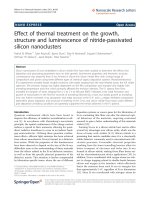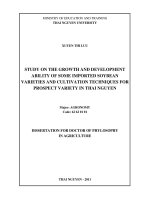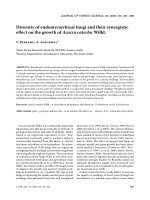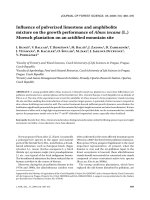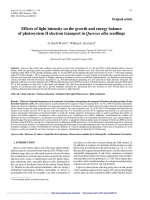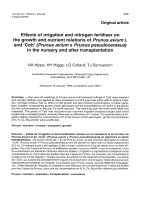Performance of ridge and furrow system on the growth and yield attribution of soybean in Barwani district of M.P. India
Bạn đang xem bản rút gọn của tài liệu. Xem và tải ngay bản đầy đủ của tài liệu tại đây (163.51 KB, 7 trang )
Int.J.Curr.Microbiol.App.Sci (2018) 7(8): 499-505
International Journal of Current Microbiology and Applied Sciences
ISSN: 2319-7706 Volume 7 Number 08 (2018)
Journal homepage:
Original Research Article
/>
Performance of Ridge and Furrow System on the Growth and Yield
Attribution of Soybean in Barwani District of M.P. India
A.L. Basediya1*, Sunita Mishra2, Rajesh Gupta3, P. Kumar4 and S.S. Basediya5
1
(Agril Engg), Krishi Vigyan Kendra (RVSKVV) Shivpuri (MP)-473551, India
2
Krishi Vigyan Kendra (RVSKVV) Aron, Guna (MP), India
3
(Agril. Engg), Krishi Vigyan Kendra (RVSKVV) Mandsaur, India
4
Krishi Vigyan Kendra (RVSKVV) Shivpuri, India
5
College of Agriculture Engineering, J.N.K.V.V., Jabalpur, India
*Corresponding author
ABSTRACT
Keywords
Soybean, Ridge and
Furrow, Growth and yield
character, Net profit, B: C
ratio
Article Info
Accepted:
06 July 2018
Available Online:
10 August 2018
The field experiment was conducted during the two consecutive Kharif season of 2011 and
2012 to study ridge and furrow in-situ conservation system for soybean crop at farmer’s
fields in Badwani district of Madhya Pradesh under Nimar agro-climatic region. Result
showed that growth and yield contributing character viz. plant population, plant height,
root length, root nodules, pods per plant, seed yield weight per plant, seed yield, straw
yield and harvest index (%) found higher in ridge and furrow system compared to the
normal flatbed sowing method which subsequently resulted in yield enhancement to the
extent of 8-23 % for soybean crop. Economic analysis revealed that the net profit was
recorded higher under ridge and furrow system compared to normal flatbed sowing. B: C
ratio was recorded as 3.35 and 3.23 under ridge and furrow system while 2.83 and 2.77
under flat sowing system for the year of 2011 and 2012 respectively.
Introduction
Soybean (Glycine max L.) ranks first amongst
oilseed crops in the world and it contributes
nearly 25 per cent of worlds total oil and fat
production. In India, soybean is topmost
oilseed crop currently covering 11.23m ha
area with expected production of 14.22
millions tones and productivity of 1266 kg per
ha (Jadon, 2016). Madhya Pradesh is known
as the “soybean state” of India, comprising
55% of the total national area 5.56 million
hectare of soybean cultivation. Soybean has
established its reorganization as both pulses
and an oilseed crop. It is the cheapest and
richest source of high quality protein
containing 38-44% protein and 18-22% oil. It
supplies most of the nutritional constituents
essential for human health. Hence, soybean is
called as wonder crop or golden bean or
miracle bean. India is the third largest
importer of soya oil in the world and is one of
the major exporters of soya meal to the other
Asian countries (Anonymous, 2013). The
average annual rainfall in Barwani district
assured 676 mm per annum. The rainfed
agriculture suffers from a number of hydrophysical and socio-economic constraints,
499
Int.J.Curr.Microbiol.App.Sci (2018) 7(8): 499-505
which affect the productivity of rainy and
post-rainy season crops. These include erratic
and undependable rainfall, excess and
deficient moisture with in a season, harsh
thermal regime, soil loss, low level of input
use and technology adoption and resource
poor farmers (Gupta, 2002). Soybean is a
major crop grown during the Kharif season in
the rain fed areas of central India.
The flat-land cultivation system is popular in
Nimar Agro-climatic zone of Madhya Pradesh
state. The crop experiences moisture stress
during the dry spell ranging from 15 to 21
days at any growth stage under rainfed
conditions, resulting significant reduction in
the yield. These yield losses are expected at
higher level especially in early genotype with
determinate types. At present for extensively
cultivation of Kharif crop like soybean which
faces the problem of water logging and poor
aeration thereby affecting crop productivity
adversely. Among all legumes soybean is
most sensitive to soil moisture. After few
showers the monsoon rains in July – August
are usually heavy and frequent. Under such
situation water logging is a common problem
which affects early growth, root proliferation
and final yield performance of crop. Excess
and continuous rains may create bad drainage
and restricts aeration, which results in nonavailibility of plant nutrients and poor
microbial activities. Extreme variability in the
quantity, time and duration of rains expose the
soybean crop to soil moisture deficit as well as
excess moisture either on account of delayed
monsoon, longer dry spells or early
withdrawal mansoon has been identified as
one of the major factors for poor performance
of soybean crops (Tiwari,2014; Gupta et. al.,
2018). During to extreme rainfalls events,
soybean crop gets also affected by water
logging problems due to improper drainage.
Water logging adversely affects the growth of
crops, primarily due to reduced oxygen supply
to the roots
The loss in yield can be avoided or minimized
if good amount of water is stored in the soil
during rainy days and utilized by the crop
during moisture stress or dry spell. Whereas,
at the same time there should be provision for
drainage of excess rain water. Under such
condition soybean planted on ridges yielded
considerably higher than planted on flat bed
(Saraf and Ahlawat, 1975) and (Patil et al.,
2010). Studies on soil management for
increasing crop production revealed that use of
various tillage methods and modification of
land configurations such as broad bed furrow,
ridges and furrow for soybean in vertisols
were superior over flat bed and recommended
in watershed development for moisture
conservation as well as for safe removal of
excess rain water (Raut and Taware, 1997).
The small change through land configuration
in flat field conditions may help in improving
the productivity of Kharif crops in Vertisols of
Nimar region. There is a need for in-situ soil
and water conservation and proper drainage
technology in black soils. This technology has
many
advantages
including
in-situ
conservation of rainwater in furrows, better
drainage of excess water and proper aeration
in the ridge and root zone. More than 300
farmers in Barwani district adopted the
technology. Majority of the area under
soybean –wheat based cropping system is in
Central India and is covered under Vertisols
and associated soils (Bhatnagar and Joshi
1999). These soils are potentially productive,
if managed properly in terms of overcoming
soil, water and nutrient management
constraints.
Now, the only way to increases the production
of soybean left is to make concerted efforts in
improvement in productivity of crops.
Besides, other techniques the In-situ
conservation of rainwater at farm level by
adopting holistic approach to the management
of rainwater like broad-bed and furrow, ridge
and furrow, tied ridging, raised and sunken
500
Int.J.Curr.Microbiol.App.Sci (2018) 7(8): 499-505
bed and compartmental bunding etc. by which
crop productivity is substantially increased.
Land treatments (raised sunken bed system,
ridges and furrows, broad bed and furrows)
increased in situ soil moisture conservation,
minimized runoff, and soil erosion (Singh
et.al., 1999 and Nagavallemma et al., 2005)
and increased the yield of principal crops
grown in the region (Mandal et al., 2005;
Rajput et al., 2009). Hari Ram et al., 2012
concluded that raised bed, raised broad bed
and ridge furrow sowing of soybean should be
advocated over flatbed sowing mainly due to
their ability to save irrigation water.
The strategy for soil moisture management is
therefore; to maximize use of rainfall by
increasing infiltration and moisture retention,
encourage surface drainage and reducing
runoff and soil erosion for getting high yield.
In view of the above fact the study was
undertaken. This paper presents the results of
ridge and furrow system on growth and yield
of soybean crop in Barwani district of MP.
Materials and Methods
The field experiment was conducted at the
farmer’s fields in Barwani district of Madhya
Pradesh during Kharif seasons 2011 and 2012.
The field study was performed with ridge and
furrow system. To make the ridge and furrow
system an extra punji is attached on the back
tines of tractor operated seed-cum-fertilizer
drill machine.
The width of panji depends upon the row to
row distances. Sowing seeds by front line tines
and covering them by soil took place by punji
attached in back line tines. Thus lines of
soybean automatically come over ridge
favoured by formation of alternate furrows.
This ridge and furrow system involves sowing
of crop at a row spacing of 30 cm while in flat
sowing method is done at a row 22 cm in
medium black soil. The average rainfall of
562.2 and 469.9 mm received during the year
2011 and 2012 respectively. The soybean crop
(variety JS 95-60) was sown for the study. The
recommended fertilizer dose of 30 kg N and
60 kg P2O5/ha was applied as urea (46% N)
and single superphosphate (16% P2O5) before
sowing soybean.
The plant growth character and yield
contributing data such as are plant height, root
length, number of root nodules per plant,
number of pods per plant, number of seeds per
pod, seed yield per plant, seed yield and straw
yield were recorded of soybean crop for sown
by ridge and furrow system and flat sowing.
Harvest index is the ratio of economic yield
(kg/ha) to biological yield (kg/ha) and
multiplied by 100 to obtain its value in
percentage. It indicates the efficiency of plant
material to convert the photosynthate in to the
economic yield and it is worked out as:
Economic yield (kg/ha)
Harvest index (%) = ------------------ X 100 (1)
Biological yield (kg/ha)
Where, the biological yield = Seed yield +
Stover yield
Economic analysis
Cost of cultivation
The cost of cultivation (Rs/ha) of each
treatment was worked out by considering the
price of inputs, charges for cultivation, labour
and other charges.
Gross monetary returns
The gross monetary returns (Rs/ha) occurred
due to different treatments in the present study
were worked out by considering market prices
of economic product, by product and crop
residues during the experimental year.
501
Int.J.Curr.Microbiol.App.Sci (2018) 7(8): 499-505
Net monetary returns
The net monetary returns (Rs/ha) of each
treatment were worked out by deducting the
mean cost of cultivation of each treatment
from the gross monetary returns gained from
the respective treatments.
Benefit: Cost ratio
The benefit: cost ratio of each treatment was
calculated by dividing the gross monetary
returns by the mean cost of cultivation
Results and Discussion
The results obtained from the present
investigation as well as relevant discussion
have been summarized under following heads:
Growth
and
yield
characteristics of soybean
attributing
Growth and yield attributing characteristics of
soybean are presented in Table 1. Table
revealed that the plant growth and yield
parameters were found better in ridge and
furrow system as compared to normal flatbed
sowing. Its due to proper drainage of excess
rainfall through furrows. Similar results were
reported by Ralli and Dhingra (2003) and he
found that the higher nodule count under ridge
sowing when compared with flat sowing for
soybean crop.
The plant population/m2 ranged 17-18 %
higher on planting soybean using ridge and
furrow seed cum fertilizer drill machine as
compared to planting on flat land with normal
seed drill. The lowest number of root nodules
per plant was recorded under flatbed sowing;
however, highest number of root nodules per
plant was produced under ridge and furrow
system. The highest productivity of 1564
kg/ha observed in the ridge and furrow system
where as it was found lowest under normal
flatbed sowing (1271 kg/ha) for year 2011 and
same trend was observed in the year 2012
also. Similar result was reported by Verma
(2008) for productivity of soybean in
Vertisols. He reported that ridge and furrow
sowing and broad bed and furrow sowing
produced
significantly
higher
growth
parameters, yield and yield attributes and root
parameters as well. He found higher seed and
straw
yield
under
modified
land
configurations as compared to the traditional
planting system. Jat and Singh (2003) reported
higher
biological
yield
from
land
configuration treatment as compared to
conventional system. Ram et al., (2011) also
concluded that ridge and furrow sowing of
soybean should be advocated over flatbed
sowing mainly due to their ability to save
irrigation water. Kumari and Rao (2005)
reported that the crop growth rate and net
assimilation rate were higher when crops are
planted on ridge and furrow or bed planting
system for mustard. Jadav et al., (2012) and
Dhakad et al., (2014 and 2015) found higher
growth parameters, yield and yield attributes
parameters in ridge and furrow system over
flat sowing system in soybean. Similar trends
reported by Bhargav et al., (2013).
Economics analysis
Economic analysis of soybean is presented in
Table 2. It reveals that higher net return of Rs
32920 per ha with B: C ratio of 3.35 is
recorded in ridge and furrow system whereas,
the lowest net return of Rs 24660 per ha with
and B: C ratio of 2.82 was recorded under
normal flatbed sowing for year 2011 and same
trends observed during year 2012. Similar
results reported by Jain and Dubey (1998); Jat
and Singh (2003); Verma (2008), Bhargav et
al., (2013) and Dhakad et al., (2014 & 2015).
They concluded that the higher gross as well
as net monetary returns were recorded under
ridge and furrow planting as compared
conventional system.
502
Int.J.Curr.Microbiol.App.Sci (2018) 7(8): 499-505
Table.1 Growth character and field attributes of soybean
Parameters
Plant population (No./m2)
Plant height (cm) at harvest
Root length (cm) at 60 DAS
Number of root nodules per
plant at 60 DAS
Number of pods per plant
Seed yield weight per plant (g)
Seed yield (kg/ha)
Straw yield (kg/ha)
Harvest index (%)
Ridge and
furrow system
Kharif
Kharif
2011
2012
46.4
48.2
68.4
70.2
24.8
25.6
30.8
31.2
Normal flatbed % change
sowing
over
control
in
Kharif Kharif
2011
2011
2012
39.4
40.6
17.77
61.4
60.8
11.40
19.2
20.2
29.17
25.2
26.6
22.22
49.43
5.84
1564
1821
46.20
36.1
4.85
1271
1490
46.03
50.22
5.86
1510
1705
45.81
37.38
4.99
1395
1596
46.64
% change
over
control in
2012
18.72
15.46
26.73
17.29
36.93
20.41
23.05
22.21
0.37
34.35
17.43
8.24
6.83
0.70
% change
over
control in
2011
33.50
18.79
% change
over
control in
2012
30.42
16.61
Table.2 Economics analysis of soybean production
Parameters
Net returns (Rs/ha)
Benefit: cost ratio
Ridge and
furrow system
Kharif Kharif
2011
2012
32920
31300
3.35
3.23
On the basis of this study, the better results of
two consecutive years were found in ridge
and furrow planting system on the growth and
yield characters of soybean as compared to
conventional method of sowing i.e. normal
flatbed sowing. It is concluded that ridge and
furrow sowing of soybean should be
advocated over flatbed sowing mainly due to
the soil moisture stored sustains the crop
during dry spells.
Normal flatbed
sowing
Kharif Kharif
2011
2012
24660
24000
2.82
2.77
seeds: A water management approach
for increased soybean production in
Madhya
Pradesh.
Journal
of
Interacademicia 17(2): 245-253
Bhatnagar, P.S. and Joshi, O.P. (1999).
Soybean in cropping systems in India,
Integrated crop management series,
FAO, Rome. 3: 1-39.
Dhakad, S S, A K Badaya, S S Chauhan, and
G S Gathiye (2015). Effect of ridge and
furrow system on the growth character
and yield in rainfed soybean in Madhya
Pradesh. Indian Journal of ecology
42(1): 230-232
Dhakad, S S, Vijay Agrawal and Sanjeev
Verma (2014). Effect of ridge and
furrow system on the growth character
and productivity of rainfed soybean in
References
Anonymous (2013). Second estimate of
soybean crop survey: Kharif (2013).
Press Release. The Soybean Processors
Association of India.
Bhargav K S, V K Jain and Umat R (2013).
Ridge and furrow system of planting
503
Int.J.Curr.Microbiol.App.Sci (2018) 7(8): 499-505
Vidisha district of M.P. Res. Environ.
Life Sci. 7(3): 211-212
Gupta R K (2002). National resources
conservation technologies for black clay
soil region of Peninsular India. Journal
of Indian Society of Soil Science 50(4):
438-447.
Gupta Rajesh, Kulmi G.S, Basediya, A.L. and
Mohan Jadav (2018). Influence of
furrow irrigated raosed bed seed drill on
growth characteristics and yield of
soybeanin Mandsaur district of Madhya
Pradesh, India. Plant Archives 18(1):
320-324.
Hari Ram, Guriqbal Singh, Navneet Aggarwal
and Jagmeet Kaur (2012). Soybean
(Glycine max) growth, productivity and
water use under different sowing
methods and seeding rates in Punjab.
Indian Journal of Agronomy 56 (4):
377-380.
Jadhav, J A, Patil, D B, Ingole P G (2012).
Effect of mechanization with different
land configuration on yield and in situ
moisture conservation of soybean.
Internat. J. agric. Sci., 8(1): 48-51
Jadon, C.K., Dashora, L. N., Mundra, S. L.
and Upadhyay, B. (2016). Effect of
Weed Management and Fertility Levels
on Productivity and Economics of
Soybean [Glycine max (L.) Merr.] in
South-Eastern Rajasthan.
Soybean
Research, 14(2): 84-88 (2016)
Jain, M.P., and Dubey, A.K. (1998).
Productivity and economic viability of
soybean with respect to planting
systems and cultivars in vertisol. Crop
Research, 16: 102-22.
Jat L N and Singh S M 2003. Varietal
suitability, productivity and profitability
of wheat (Triticum species) intercrops
and relay cropping under furrowirrigated raised bed system. Ind. J.
Agriculture Sci., 73(4):187-190.
Kumari C R and Rao D S K (2005). Effect of
land treatments and dates of sowing on
growth parameters of mustard (Brassica
juncea L.). J. Oilseeds Research 22(1):
188-189.
Mandal D K, Mandal C and Venugopalan M
V (2005). Suitability of cotton
cultivation in shrink–swell soils in
central India. Agricultural Systems 84:
55–75.
Nagavallemma K P, Wani S P Reddy, M S
and Pathak, P (2005). Effect of
landform and soil depth on productivity
of soybean based cropping systems and
erosion losses in Vertic Inceptisols. Ind.
J. Soil Conservation, 33(2): 132–136.
Rajput R P, Kauraw D L, Bhatnagar R K,
Bhavsar M, Velayutham M and Lal R
(2009). Sustainable management of
vertisols in central India. J. Crop
Improvement 23: 119–135.
Ralli S and Dhingra K K (2003). Response of
soybean to different planting methods.
Annals of Biology 19(2): 151-155.
Ram Hari, Singh Guriqbal, Aggarwal Navneet
and Kaur Jagmeet (2011). Soybean
(Glycine max) growth, productivity and
water use under different sowing
methods and seeding rates in Punjab.
Indian Journal of Agronomy 56 (4):
377-380
Raut, V.M. and Taware, S.P. (1997).
Comparison of different sowing
methods in soybean. J. Maharashtra
Agric. Univ., 25 (2): 218-219.
Singh P, Alagarswamy G, Pathak P, Wani S
P, Hoogenboom G and Virmani S M
(1999). Soybean-chickpea rotation on
Vertic Inceptisol: 1.Effect of soil depth
and landform on light interception,
water balance and crop yields. Field
Crops Research 63:211-224. II. Longterm simulation of water balance and
crop yields. Field Crops Research.
63(3): 225-236.
Tiwari, S.P. (2014). Raising the yield ceiling
in soybean. An Indian overview.
Soybean Research, 12(2): 1-43.
504
Int.J.Curr.Microbiol.App.Sci (2018) 7(8): 499-505
Verma Mukesh (2008). Effect of land
configurations and seed rates on the
growth and productivity of rainfed
soybean grown in Vertisols. M.Sc. (Ag.)
Thesis, JNKVV, Jabalpur (M.P.).
How to cite this article:
Basediya, A.L., Sunita Mishra, Rajesh Gupta, P. Kumar and Basediya, S.S. 2018. Performance
of Ridge and Furrow System on the Growth and Yield Attribution of Soybean in Barwani
District of M.P. India. Int.J.Curr.Microbiol.App.Sci. 7(08): 499-505.
doi: />
505

